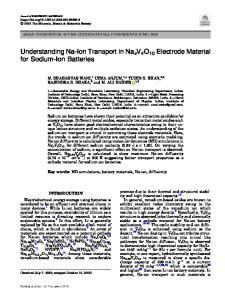Electrode potential studies of liquid-solid equilibrium in Na 3 Bi-Saturated Na-Bi melts
- PDF / 126,884 Bytes
- 4 Pages / 612 x 792 pts (letter) Page_size
- 15 Downloads / 311 Views
Y. YAN, Lecturer, is with the Research Centre for Metallurgical Process Engineering, Institute for Advanced Materials Processing, Tohoku University, Sendai, Japan 980-77. D.E. LANGBERG, Project Leader, and W.J. RANKIN, Research and Development Manager, are with CSIRO Minerals, Clayton, Victoria, Australia 3169. Manuscript submitted May 25, 1999. METALLURGICAL AND MATERIALS TRANSACTIONS B
mm in diameter was then passed through the hole and placed in contact with the bismuth. The small gap between the disc and the sheath was also filled with cement for both the reference and working electrodes. The Bi-Na alloy bath was prepared by melting the required amounts of the metals in a high purity graphite crucible, 45-mm i.d. by 49-mm o.d. and 100-mm high, under a dry and deoxidized argon atmosphere. The melt was held for 3 days at 593 K. The furnace power was then switched off to allow the melt to cool under a dry and deoxidized argon atmosphere. The alloy was then stored in an evacuated desiccator ready for use. To make a galvanic cell, two half-cells (a working electrode and a reference electrode) were immersed to the same depth in molten Na-Bi alloy in a high purity graphite crucible. Solidstate coulometric titration was used to prepare in situ the twophase alloys in the working electrode and the pure sodium reference electrode. Electrical connection to the Na-Bi alloy was made using a 1-mm-diameter molybdenum wire. The method involved additions of sodium to the metals inside the electrodes by passing a constant d.c. current (current density less than 50 mA/cm2) across the electrolytes between the metals and the surrounding Na-Bi alloy bath. The sodium present in the electrodes was thus extremely pure and free of oxides. The cells were operated under a dry and deoxidized argon atmosphere during the experiments. After each experiment, the used electrolyte tubes were examined for possible reactions with the electrode materials by means of a scanning electron microscope (SEM) with an energy dispersive system for analysis. Figures 2 and 3 show the variations of the cell emfs with temperature for the Na (l) 1 Na3Bi (s) and Bi (l) 1 Na3Bi (s) systems, respectively. It was found that the emfs of the cells for both systems returned within 60.2 mV to their original values after cycling the temperatures, indicating that the cells behaved reversibly in the ranges investigated. The potentials of the two-phase electrodes also showed excellent stability at each temperature over a period of 1 hour (standard deviation was less than 60.05 mV) with respect to small changes in alloy composition as long as the two phases coexisted. This was similar to that observed by Saboungi et al. for solid Li3Bi-saturated Li-Bi melts.[18] The SEM results showed that there were no reactions between the electrolytes and pure liquid sodium or molten Na-Bi alloys. No chemical attack of the electrode leads (tantalum and molybdenum) by the electrode materials was observed. The activity and the relative partial molar Gibbs free energy of sodium in solid Na3Bi-
Data Loading...











